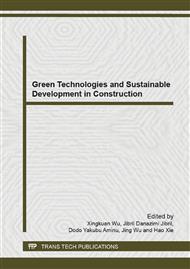[1]
Yew, M.C. and N. Ramli Sulong, Fire-resistive performance of intumescent flame-retardant coatings for steel. Materials & Design, 2012. 34: pp.719-724.
DOI: 10.1016/j.matdes.2011.05.032
Google Scholar
[2]
Jimenez, M., S. Duquesne, and S. Bourbigot, Characterization of the performance of an intumescent fire protective coating. Surface and coatings Technology, 2006. 201(3): pp.979-987.
DOI: 10.1016/j.surfcoat.2006.01.026
Google Scholar
[3]
Wang, G. and J. Yang, Thermal degradation study of fire resistive coating containing melamine polyphosphate and dipentaerythritol. Progress in Organic Coatings, 2011. 72(4): pp.605-611.
DOI: 10.1016/j.porgcoat.2011.07.001
Google Scholar
[4]
Wang, Z., E. Han, and W. Ke, Influence of nano-LDHs on char formation and fire-resistant properties of flame-retardant coating. Progress in Organic Coatings, 2005. 53(1): pp.29-37.
DOI: 10.1016/j.porgcoat.2005.01.004
Google Scholar
[5]
Li, G., et al., Effects of EG and MoSi<sub> 2</sub> on thermal degradation of intumescent coating. Polymer degradation and stability, 2007. 92(4): pp.569-579.
DOI: 10.1016/j.polymdegradstab.2007.01.018
Google Scholar
[6]
Jimenez, M., S. Duquesne, and S. Bourbigot, Intumescent fire protective coating: toward a better understanding of their mechanism of action. Thermochimica acta, 2006. 449(1): pp.16-26.
DOI: 10.1016/j.tca.2006.07.008
Google Scholar
[7]
Ullah, S., F. Ahmad, and P. Yusoff, Effect of boric acid and melamine on the intumescent fire‐retardant coating composition for the fire protection of structural steel substrates. Journal of Applied Polymer Science, (2012).
DOI: 10.1002/app.38318
Google Scholar
[8]
Kneer, M.J., et al., A cost-effective approach to evaluate insulative materials for low heat flux applications. 1993, Washington, DC (United States); American Institute of Aeronautics and Astronautics (AIAA).
DOI: 10.2514/6.1993-840
Google Scholar
[9]
Koo, J.H., P.S. Ng, and F.-B. Cheung, Effect of high temperature additives in fire resistant materials. Journal of Fire Sciences, 1997. 15(6): pp.488-504.
DOI: 10.1177/073490419701500605
Google Scholar
[10]
Wang, Z., E. Han, and W. Ke, Influence of expandable graphite on fire resistance and water resistance of flame-retardant coatings. Corrosion Science, 2007. 49(5): pp.2237-2253.
DOI: 10.1016/j.corsci.2006.10.024
Google Scholar
[11]
Li, G., et al., An Investigation of the thermal degradation of the intumescent coating containing MoO<sub> 3</sub> and Fe<sub> 2</sub> O<sub> 3</sub>. Surface and coatings Technology, 2008. 202(13): pp.3121-3128.
DOI: 10.1016/j.surfcoat.2007.11.016
Google Scholar
[12]
Gu, J.-w., et al., Study on preparation and fire-retardant mechanism analysis of intumescent flame-retardant coatings. Surface and coatings Technology, 2007. 201(18): pp.7835-7841.
DOI: 10.1016/j.surfcoat.2007.03.020
Google Scholar
[13]
Levchik, S., L. Costa, and G. Camino, Effect of the fire-retardant ammonium polyphosphate on the thermal decomposition of aliphatic polyamides. Part III—Polyamides 6.6 and 6.10. Polymer degradation and stability, 1994. 43(1): pp.43-54.
DOI: 10.1016/0141-3910(94)90224-0
Google Scholar


